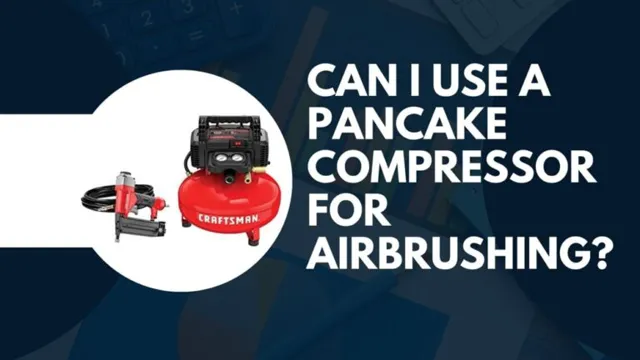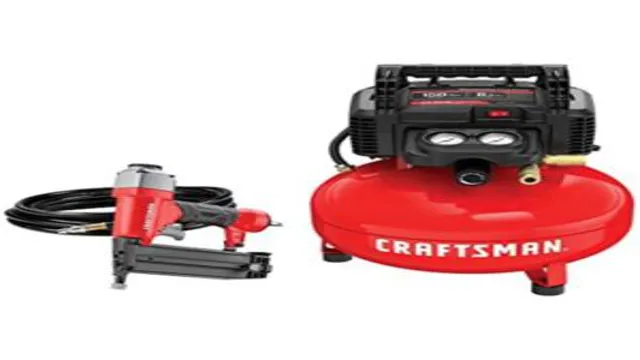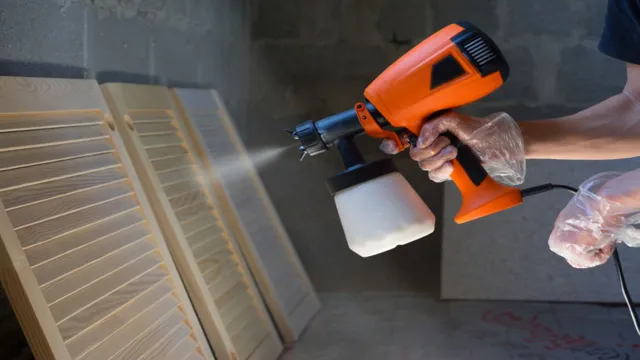Can a Pancake Compressor Run a Paint Sprayer? Here’s What You Need to Know.

If you’re an amateur painter looking to spruce up your home, one question you might be asking yourself is whether your pancake compressor can run a paint sprayer efficiently. The answer to that question is simple. Yes, a pancake compressor can run a paint sprayer, but whether it will provide enough power to enable you to achieve a good finish is entirely dependent on the size and type of paint sprayer you choose.
Using a paint sprayer is an excellent way to make painting large surfaces more efficient. However, it can be challenging to get the desired finish if you don’t use the correct tools. In this article, we’ll explore how a pancake compressor can work with a paint sprayer and give you tips on selecting the best paint sprayer for your specific needs.
Understanding Pancake Compressors
If you’re wondering if a pancake compressor can run a paint sprayer, the answer is yes, but there are some things you need to consider before using it. The first thing you need to check is the air flow rate of the compressor. Most paint sprayers require a high volume of air to operate, so you need to make sure that your compressor can provide the necessary airflow.
A pancake compressor typically has a lower air flow rate than other compressors, so you may need to invest in a larger compressor or a pressure pot if you plan on using it for painting projects regularly. Another thing to keep in mind is the size of the compressor tank. Pancake compressors typically have smaller tanks, which means that they may not provide a continuous supply of air.
This can be problematic when you’re painting, as you may need to stop frequently to wait for the compressor to refill. With these things in mind, you can successfully run a paint sprayer with a pancake compressor as long as you choose the right one for your needs.
What is a pancake compressor?
A pancake compressor is a small, portable air compressor that is shaped like a pancake. It is lightweight, compact, and easy to transport, making it perfect for jobs where mobility is essential. Pancake compressors are ideal for low to medium duty tasks, such as inflating tires, powering pneumatic tools, and driving nails.
The primary selling point of a pancake compressor is its portability. It is compact enough to fit in the trunk of most cars and light enough to be carried by hand. Pancake compressors are also relatively affordable and require minimal maintenance.
They are perfect for DIY enthusiasts, hobbyists, and contractors who need a compressor on-the-go. If you have a small studio or garage and require a compressor that doesn’t take up too much space, then a pancake compressor is an excellent choice. Overall, pancake compressors are an essential tool for anyone who needs compressed air on-the-go.
They are versatile, reliable, and easy to use, making them ideal for low to medium duty tasks. Whether you’re a DIYer or a professional contractor, a pancake compressor is a must-have addition to your toolkit.

What are its specs and limitations?
When it comes to portable air compressors, pancake compressors are a popular choice due to their compact and lightweight design. They typically have a low profile and are easy to carry around, making them the perfect option for DIY projects and small-scale construction. One of the major advantages of pancake compressors is their quick recovery time since they have a larger tank than other portable compressors.
This feature allows them to provide continuous airflow for extended periods of time. However, it’s important to note that pancake compressors have their limitations. They typically have a lower maximum pressure than other compressors and may not be powerful enough to handle heavy-duty tasks.
Additionally, they tend to be noisier than other portable compressors, which may be an issue when working in close proximity to others. Overall, pancake compressors are an excellent choice for those looking for a compact and portable option for smaller projects.
Paint Sprayers and Their Requirements
Many people assume that a pancake compressor won’t be able to power a paint sprayer, but that isn’t the case. While bigger, more powerful compressors may be preferred, smaller models like pancake compressors can run paint sprayers just fine. However, it’s important to note that the PSI and CFM ratings of the compressor must match the requirements for the paint sprayer being used.
Most paint sprayers need at least a 50 PSI rating and 3-4 CFM to operate effectively. So before purchasing a compressor, it’s crucial to check and ensure that it meets these requirements. Investing in a compatible compressor will ensure that your paint sprayer works as it should without any hiccups.
Brighten up any space with a freshly coated paint job, using your trusty pancake compressor and paint sprayer combination.
Types of paint sprayers
Paint sprayers come in different shapes, sizes, and requirements. Understanding the types of paint sprayers available in the market will help in selecting the right one for your particular project. Airless paint sprayers are the most commonly used ones, making use of high pressure to break the paint into small droplets for even coverage.
HVLP paint sprayers, on the other hand, offer a higher transfer rate, reducing the amount of overspray generated. While compressed air sprayers require a separate compressor to operate, they offer a high pressure and medium-range finish. Regardless of the type, choosing the right paint sprayer for your project depends on factors such as the surface area, the type of paint, and the overall project size.
Knowing the differences between the types of paint sprayers ensures a more efficient painting process with professional-quality results.
What are their requirements?
Paint sprayers are widely used by professionals in the painting industry, and in recent years, they have become popular among DIY enthusiasts as well. When it comes to the requirements of paint sprayers, there are a few things to keep in mind. Firstly, the type of paint being used will play an important role in determining the requirements of the sprayer.
Thicker coatings, such as lacquers and enamels, will require a sprayer that has a higher PSI rating and a larger tip size. Secondly, the size of the area being painted and the type of surface will also be important factors to consider. Larger areas will require a sprayer with a larger paint capacity, while rough or uneven surfaces may require a sprayer with more power.
Finally, the type of project being undertaken will also play a role in determining the requirements of the sprayer. For example, a small touch-up job will require a different type of sprayer than a larger painting project. By taking these factors into consideration, professionals and DIY painters alike can make sure that they choose the right paint sprayer for their needs.
What are the risks of not meeting those requirements?
When it comes to paint sprayers, meeting the necessary requirements is crucial for safety and efficiency. Failing to follow these standards can result in serious risks, such as injury, property damage, and decreased performance. For instance, using the wrong type of spray gun for a particular task can lead to overspray, clogging, and uneven coatings, resulting in wasted time, money, and materials.
Additionally, ignoring safety measures such as wearing protective gear and proper ventilation can cause respiratory problems, eye irritations, and even lung damage. It is also important to adhere to the manufacturer’s instructions regarding the type of paint, pressure settings, and maintenance procedures to avoid potentially hazardous situations. Overall, ensuring that the right paint sprayer is used for the job and that all requirements are met is key to achieving optimal results and maintaining a safe working environment.
Can a Pancake Compressor Run a Paint Sprayer?
If you’ve ever wondered whether a pancake compressor can run a paint sprayer, the answer is yes – but it may not be the best option for your needs. Pancake compressors are low-capacity air compressors that are primarily used for inflating tires or powering small tools like nailers. While they can technically power a paint sprayer, the limited air supply may not provide enough pressure or volume to effectively spray paint.
Additionally, running a paint sprayer for extended periods of time can overheat a pancake compressor, leading to damage or reduced lifespan. It’s generally recommended to use a larger, high-capacity air compressor specifically designed for painting to get the best results and avoid potential mishaps. However, in a pinch, a pancake compressor can still get the job done with proper precautions and planning.
The short answer
If you are wondering whether you can use a pancake compressor to power a paint sprayer, the short answer is yes. A pancake compressor with a minimum of 2 CFM and 90 PSI can be used to run a paint sprayer, especially if it is a small or medium-sized sprayer. However, it is important to note that the paint sprayer will require a certain amount of air flow and pressure in order to operate properly.
So, it’s important to check the specifications for your specific paint sprayer and pancake compressor to ensure they are compatible. Additionally, if you plan on using the paint sprayer for long periods of time, it’s best to invest in a larger compressor to avoid overheating or wearing down your equipment.
Factors to consider
If you’re looking for a simple and affordable paint sprayer for small DIY projects, you might be wondering if your pancake compressor is up to the task. The answer is, it depends. A pancake compressor can certainly run a small paint sprayer, but you’ll need to consider a few factors before deciding if it’s the right choice for you.
First, you’ll need to check the specs of both your compressor and your sprayer. Make sure the CFM (cubic feet per minute) of your compressor is equal to or greater than the CFM requirement of your sprayer. This will ensure that your compressor can provide enough air flow to run the sprayer effectively.
Second, consider the size and complexity of your project. A pancake compressor is best suited for small, simple projects. If you’re painting a large room or a complex piece of furniture, you’ll want to invest in a larger compressor and sprayer to ensure that you can complete the job efficiently.
Finally, keep in mind that a pancake compressor will need to continually refill its tank as you work. This can slow you down and be inconvenient, especially if you’re working on a tight deadline. In conclusion, a pancake compressor can certainly run a paint sprayer, but it’s important to consider the specific requirements of your project before deciding if it’s the right choice for you.
By checking the specs, considering the size and complexity of your project, and being aware of the limitations of a pancake compressor, you can make an informed decision that will help you complete your DIY project with ease.
Techniques to make it work
If you are wondering if a pancake compressor can run a paint sprayer, the short answer is yes! A pancake compressor can absolutely run a paint sprayer, but there are a few things to consider before diving in. First, make sure the compressor has enough CFM (cubic feet per minute) to keep up with the paint sprayer. This will vary depending on the type of sprayer you are using, so be sure to check the manufacturer’s recommendations.
Also, keep in mind that pancake compressors are typically smaller and less powerful than other types of compressors, so you may need to take breaks during longer painting sessions to prevent overheating. With these factors in mind, a pancake compressor can be a great option for those looking for a budget-friendly way to power their paint sprayer.
Conclusion and Recommendation
In conclusion, just like how a pancake can be both a breakfast food and a flat round object, a pancake compressor may seem limited in its usage, but with the right attachments and modifications, it can become a versatile tool for painting projects. So, to answer the question “Can a pancake compressor run a paint sprayer?” – with some adjustments and proper setup, it definitely can! Don’t underestimate the potential hidden within the humble pancake compressor.”
FAQs
What is a pancake compressor?
A pancake compressor is a small, portable air compressor designed for light-duty tasks such as inflating tires and powering pneumatic tools.
Can a pancake compressor run a paint sprayer?
It depends on the capacity of the pancake compressor. A small pancake compressor may not have enough power or capacity to run a paint sprayer. However, some larger pancake compressors may have enough power and capacity to run a paint sprayer.
What is the minimum capacity needed in a pancake compressor to run a paint sprayer?
The minimum capacity needed in a pancake compressor to run a paint sprayer depends on the specific paint sprayer being used. It’s important to check the manufacturer’s recommendations for the pressure and CFM (cubic feet per minute) requirements of the paint sprayer before selecting a compressor.
Can I use a pancake compressor to paint my car?
Using a pancake compressor to paint a car is not recommended. It may not have enough capacity to deliver a consistent flow of compressed air, which is important for an even coat of paint.
What kind of paint sprayer is compatible with a pancake compressor?
A gravity-fed paint sprayer or a HVLP (high volume low pressure) paint sprayer is most compatible with a pancake compressor. These types of sprayers require less air pressure and volume, which can be provided by a smaller compressor.
Can I add an external air tank to my pancake compressor?
Yes, it is possible to add an external air tank to a pancake compressor to increase the capacity. However, it’s important to follow the manufacturer’s instructions and use proper safety precautions when modifying or adding to any air compressor setup.
Can I use a pancake compressor for sandblasting?
No, a pancake compressor is not suitable for sandblasting. Sandblasting requires a high volume of air and a constant flow, which most pancake compressors are not capable of providing. It’s recommended to use a larger compressor with a higher capacity for sandblasting.



